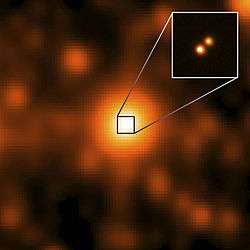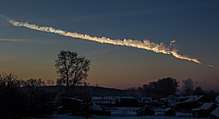Kepler-78b
Kepler-78b (formerly known as KIC 8435766 b) is an exoplanet orbiting around the star Kepler-78. At the time of its discovery, it was the exoplanet most similar to Earth in terms of mass, radius and mean density.
 Size comparison of Kepler-78 b with Earth | |
| Discovery | |
|---|---|
| Discovery date | November 5, 2013[1] |
| Transit and reflection/emission modulations (Kepler Mission) | |
| Orbital characteristics | |
| 0.01 AU (1,500,000 km) | |
| 0.355007 d | |
| Inclination | 81 +6 −9 |
| Star | Kepler-78 |
| Physical characteristics | |
Mean radius | 1.12 R⊕ |
| Mass | 1.69-1.85 M⊕ |
Mean density | 5.3-5.6 g cm−3 |
Discovery
Kepler-78b is the first planet to be found orbiting the star KIC 8435766 b, now known as Kepler-78.[2][3][4] The planet was discovered in 2013 by analyzing data from the Kepler space telescope. The planet was detected as it passed across the surface of its host star, as viewed from Earth, and was also found by the effects of occultation as it passed behind the star. Reflected light from the parent star due to orbital phases was also detected. It was not at first designated as a Kepler object of interest, as data analysis failed to identify it due to its short period.[5]
Characteristics
Size, mass and composition
At the time of its discovery, Kepler-78b was the exoplanet most similar to Earth in terms of mass, radius and mean density.[6] The planet is approximately 1.69 times the mass and 1.2 times the radius of the Earth.[7] The acceleration due to gravity on the planet's surface is about 11 m/s2, slightly greater than the surface gravity of Earth.[7] Two independent teams were involved in pioneering work to estimate the mass of the planet. Their estimates were made possible because Kepler-78b's gravity causes a 'wobble' in the orbit of the host star. While the method has been used to characterize gas giants, it is difficult to estimate the mass of Earth-sized exoplanets, because their gravity is too weak to produce a visible influence. In this case, the planet's orbit is close enough to its star to produce a detectable effect.[8]
One team, led by Francesco Pepe, used the High Accuracy Radial Velocity Planet Searcher-North (HARPS-N) spectrograph at the Telescopio Nazionale Galileo in the Canary Islands[9] to estimate that the planet has a mass 1.86 times that of the Earth and a radius 1.16 times greater. The other, led by Andrew Howard of the University of Hawaii at Manoa, used data from the High Resolution Eschelle Spectrometer on the Keck 1 Telescope at the W.M. Keck Observatory in Hawaii to estimate the mass as 1.69 times that of the Earth and the radius as 1.2 times larger. Both estimates put the planet's density at about 5.5 grams per cubic centimetre, which is equivalent to that of the Earth and possibly indicative of a rock-iron composition like Earth's.[8][10] The iron core could build up to 40% of the planet mass.[6]
Kepler-78b is most similar to larger high-density, hot exoplanets like Kepler-10b, Kepler-36b and CoRoT-7b.[6]
Environment
Kepler-78b orbits around its parent star once every 8.5 hours. It reflects 20% to 60% of the starlight it receives.[5] Due to its extremely close solar orbit, which is about 40 times closer than Mercury is to the Sun, the planet's surface is estimated to be at a temperature of 2,300 K (2,030 °C; 3,680 °F) to 3,100 K (2,830 °C; 5,120 °F).[7] This temperature is high enough to have stripped the planet of any stable atmosphere, but the liquid and solid portions of the planet should be stable.[7] According to Francesco Pepe, the planet may be Earth-sized but "it can be imagined like a lava planet rather than an Earth-like planet".[8]
Origin
According to Harvard–Smithsonian Center for Astrophysics astronomer Dimitar Sasselov, "this lava world is an abomination. There’s no physical way a small world, only 20 percent larger than Earth, could have evolved in that location and there’s no known mechanism that could have transported it there. But one thing that is certain, it can’t stay roasting in that hellish orbit for long; it’s destined to get swallowed by its star very soon".[11] It is estimated that the planet will be swallowed by its parent star in about three billion years.[12][13]
References
- http://apod.nasa.gov/apod/ap131105.html
- Transits and occultations of an Earth-sized planet in an 8.5-hour orbit
- http://exoplanetarchive.ipac.caltech.edu/cgi-bin/DisplayOverview/nph-DisplayOverview?objname=Kepler+78+b&type=CONFIRMED_PLANET
- Chang, Kenneth (30 October 2013). "Astronomers Find Earthlike Planet, but It's Infernally Hot". New York Times. Retrieved 31 October 2013.
- Transits and occultation of an Earth-sized planet in an 8.5-hour orbit
- Pepe, F.; Cameron, A. C.; Latham, D. W.; Molinari, E.; Udry, S. P.; Bonomo, A. S.; Buchhave, L. A.; Charbonneau, D.; Cosentino, R.; Dressing, C. D.; Dumusque, X.; Figueira, P.; Fiorenzano, A. F. M.; Gettel, S.; Harutyunyan, A.; Haywood, R. L. D.; Horne, K.; Lopez-Morales, M.; Lovis, C.; Malavolta, L.; Mayor, M.; Micela, G.; Motalebi, F.; Nascimbeni, V.; Phillips, D.; Piotto, G.; Pollacco, D.; Queloz, D.; Rice, K.; Sasselov, D. (2013). "An Earth-sized planet with an Earth-like density". Nature. 503 (7476): 377–380. arXiv:1310.7987. Bibcode:2013Natur.503..377P. doi:10.1038/nature12768. PMID 24172902.
- Howard, A. W.; Sanchis-Ojeda, R.; Marcy, G. W.; Johnson, J. A.; Winn, J. N.; Isaacson, H.; Fischer, D. A.; Fulton, B. J.; Sinukoff, E.; Fortney, J. J. (2013). "A rocky composition for an Earth-sized exoplanet". Nature. 503 (7476): 381–384. arXiv:1310.7988. Bibcode:2013Natur.503..381H. doi:10.1038/nature12767. PMID 24172898.
- Gibney, Elizabeth (30 October 2013). "Exoplanet is built like Earth but much, much hotter". Nature. Retrieved 30 October 2013.
- "An Earth-like planet characterized by HARPS-N at the TNG".
- Grossman, Lisa (30 October 2013). "Astrophile: Evil twin planet makes other Earths likely". New Scientist. Retrieved 30 October 2013.
- http://news.discovery.com/space/alien-life-exoplanets/kepler-78b-mystery-exoplanet-shouldnt-even-exist-131030.htm
- http://www.cfa.harvard.edu/news/2013-25
- Strange 'Lava World' Is Most Earthlike Alien Planet Yet


